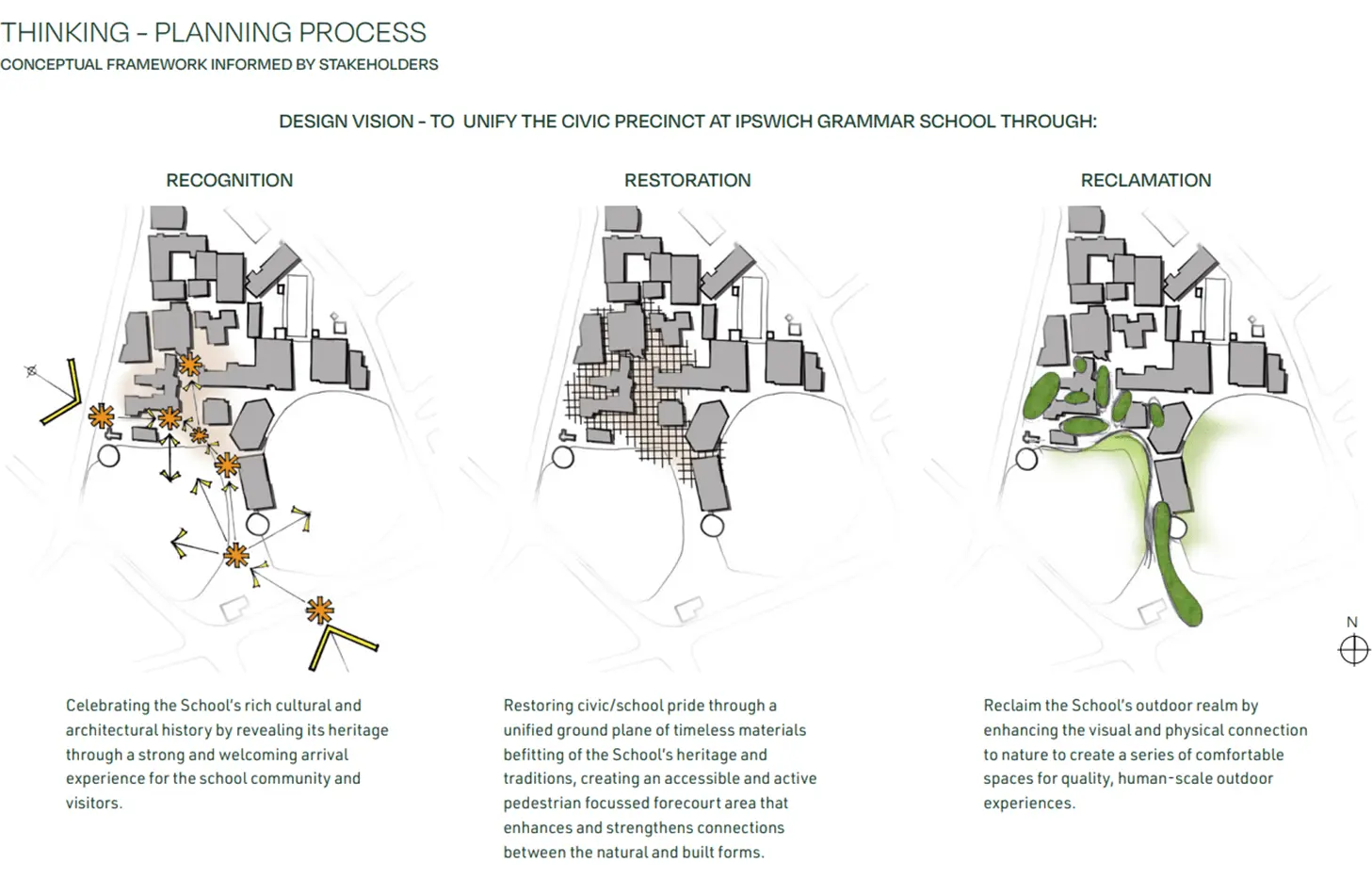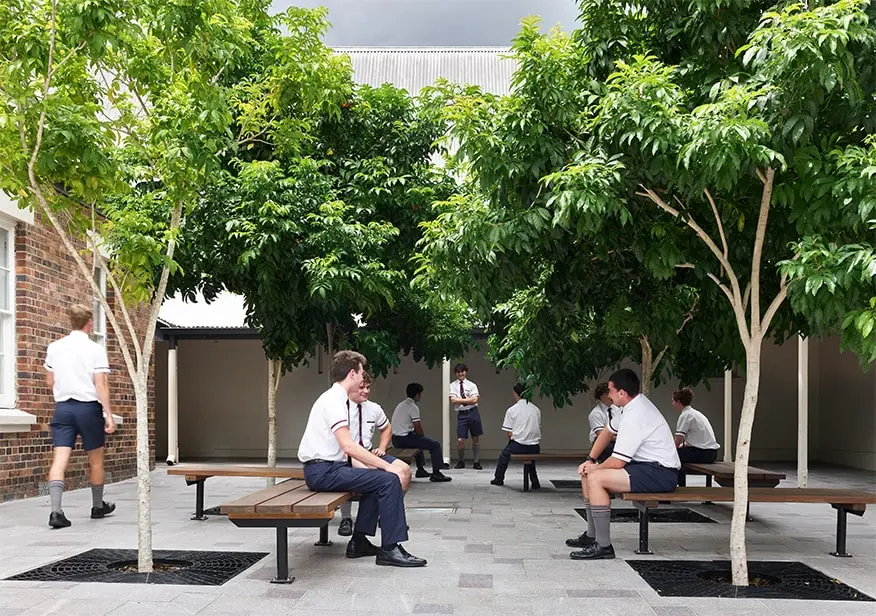
In celebrating the recent win at the Australian Institute of Landscape Architecture (AILA) 2024 QLD Landscape Architecture Awards, we thought we would share a little more about the Ipswich Grammar School Great Hall Enhancement project that won an award in the Health and Education Landscape Category.
Located 45 minutes west of Brisbane, the Ipswich Grammar School (IGS) is the oldest grammar school in Queensland and an independent day and boarding school for boys from Prep to Year 12. Recognising the need to restore the heritage significant Great Hall and modernise the surrounding landscape to support the evolving needs of their students and the community, IGS engaged Williams Architects who in turn engaged the rest of the project team.
An experienced project team
A critical factor that determines the success of a project is an experienced project team that works seamlessly together to achieve the client’s objectives. We were fortunate to work with a great project team on the IGS Great Hall Enhancement project that included the following companies:
- Architect – Andrew Williams, Williams Architects
- Landscape Architects – Marian Long & David Searle, GB-Landscape
- Heritage Specialist – Ben Gall, Australian Heritage Specialists
- Civil and Structural Engineers – Narelle Krack, Hunt Michel & Partners
- Hydraulic & Electrical Engineers – Paul Menhinnitt (Hydraulic Engineer) and Daniel Walker (Electrical Engineer), Property Technologies
- Traffic Eng: Nathan Edwards – Bitzios Consulting
Underpinned by core principles: recognition, restoration, and reclamation
The Great Hall Enhancement project was carefully executed through extensive design development and stakeholder and school community consultation, and underpinned by the core principles of Recognition, Restoration, and Reclamation.
These core principles were implemented through the recognition of the schools rich cultural and architectural history, the restoration of civic and school pride through a unified ground plane of timeless materials befitting this history, and the reclamation of the school’s outdoor realm and internal building works by enhancing the visual and physical connection in quality, human-scale spaces.

A collaborative approach to establishing design objectives
The design aimed to transform the underutilised built and environmental heritage spaces to meet contemporary teaching and learning needs. As such, the design preserved the heritage and built-form legacy while creating new landmarks and fostering a stronger sense of school identity.
Collaborating with multiple stakeholders, a defined list of design outcomes were devised to achieve a dynamic environment.
These included:
- Creating a permeable, accessible, safe spaces for IGS and its community.
- Establishing outdoor learning in a sustainable environment.
- Prioritising the creation of a supportive learning environment.
- Activating pathways to prioritise pedestrian movement.
- Showcasing the unique heritage and culture of IGS.
- Developing a prosperous IGS campus for all current and future generations of students.

The successful outcome of the project has resulted in a flexible space, which supports students, staff, and the broader community. The school has an area that is flexible, allowing learning support, outdoor education, student relaxation and play, as well as a formal public realm to the heritage site.
The design team created key arrival and event spaces at the main entrance to the Great Hall and nearby auditorium. The enhanced landscape features, including new seating terraces and garden style settings, have boosted social and cultural interactions for the students, promoting it as a dynamic social and learning landscape. There has been a remarkable uptake in usage of these areas with students and the wider school community taking ownership of the new space and creating their own traditions.
Through the project the school has seized the opportunity to bridge the fine heritage with the new modern landscape to meet the demand for a quality, future-forward precinct that reflects the potential offered at IGS. Importantly, the project has allowed for the heritage of buildings, landscape and events associated with IGS to be celebrated and protected.
Innovations through the design
Sustainable innovations:
- Increased green space and biodiverse planting areas reducing the requirement for hardscaping and reducing the heat island effect
- Water catchment utilised with inclusion of structural soil cells
Recycled water for irrigation Grading and drainage innovations:
- Extended terraced walling marrying into traditional stone retaining walls utilises the space as seating for recreation and outdoor classroom scenarios
- Terracing throughout the civic precinct drains toward planting areas to help minimise watering requirements
Circulation innovations:
- Site planning has enabled PWD pathways to be included with direct access to all main regions of the civic precinct
- Active circulation pathways are separated from congregation areas surrounding the Great Hall to relieve user conflict via micro-zoning the civic precinct

“The restoration of the Great Hall, and the rejuvenation of the landscape offers flexibility for the school, a respectful and heritage appropriate response to the state heritage significance of the structures, and environments encouraging student learning, interaction, and play. IGS overcame specific site conditions to provide a strong identity for the institution and a vibrant campus.
“WA and GB-A crafted a vision for the building and landscape that would support the learning and education of the students at IGS. The traditional teaching model of education is a teacher-centered classroom, which cannot effectively satisfy the inherent curiosity of students and stimulate their creative potential.
The need to address the contemporary modes of teaching and learning support offered by IGS required the restored building and the new landscape to be welcoming, collaborative, and sustainable.”
– Richard Morrison, Headmaster/CEO, Ipswich Grammar School
UP NEXT






























